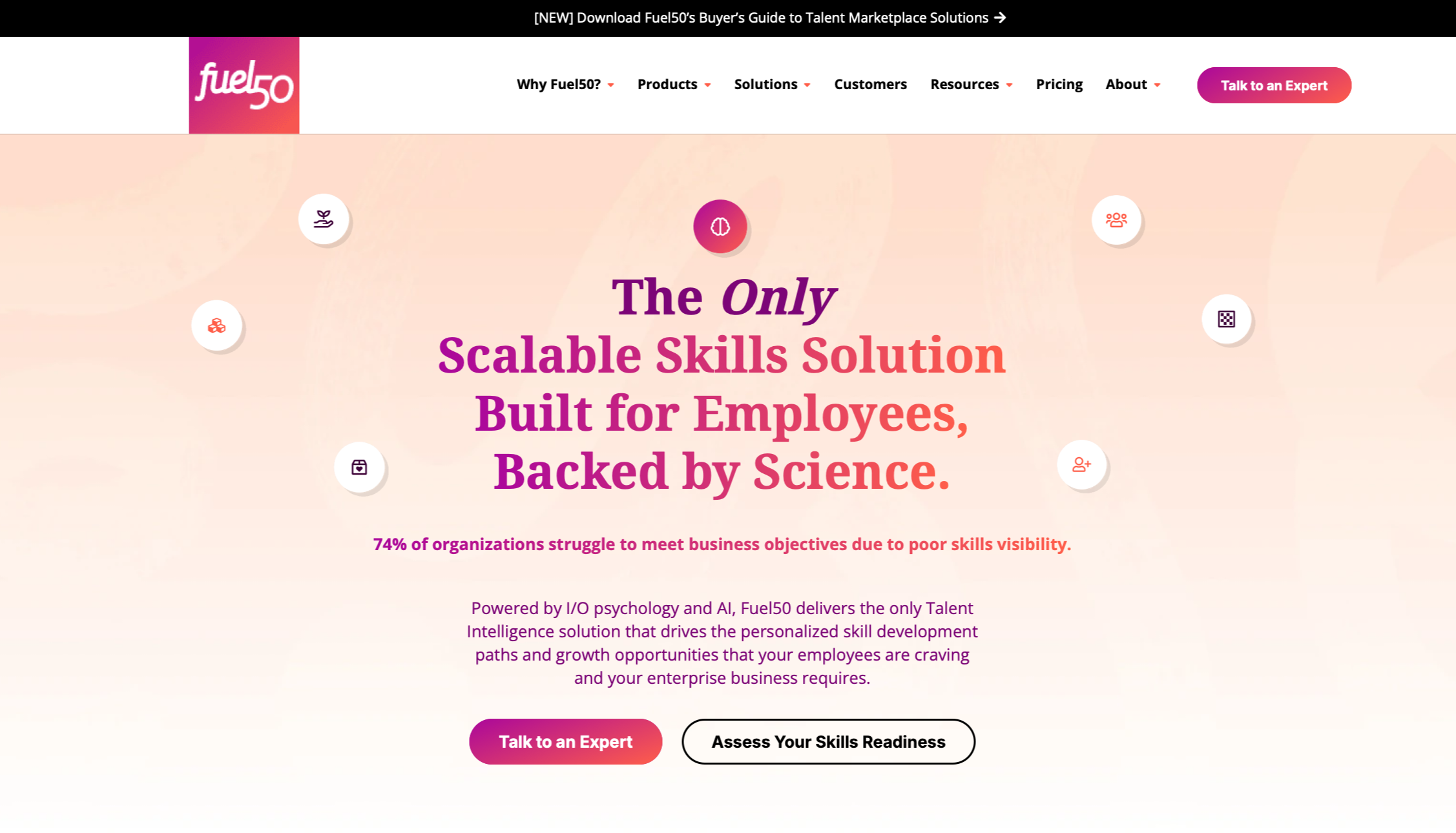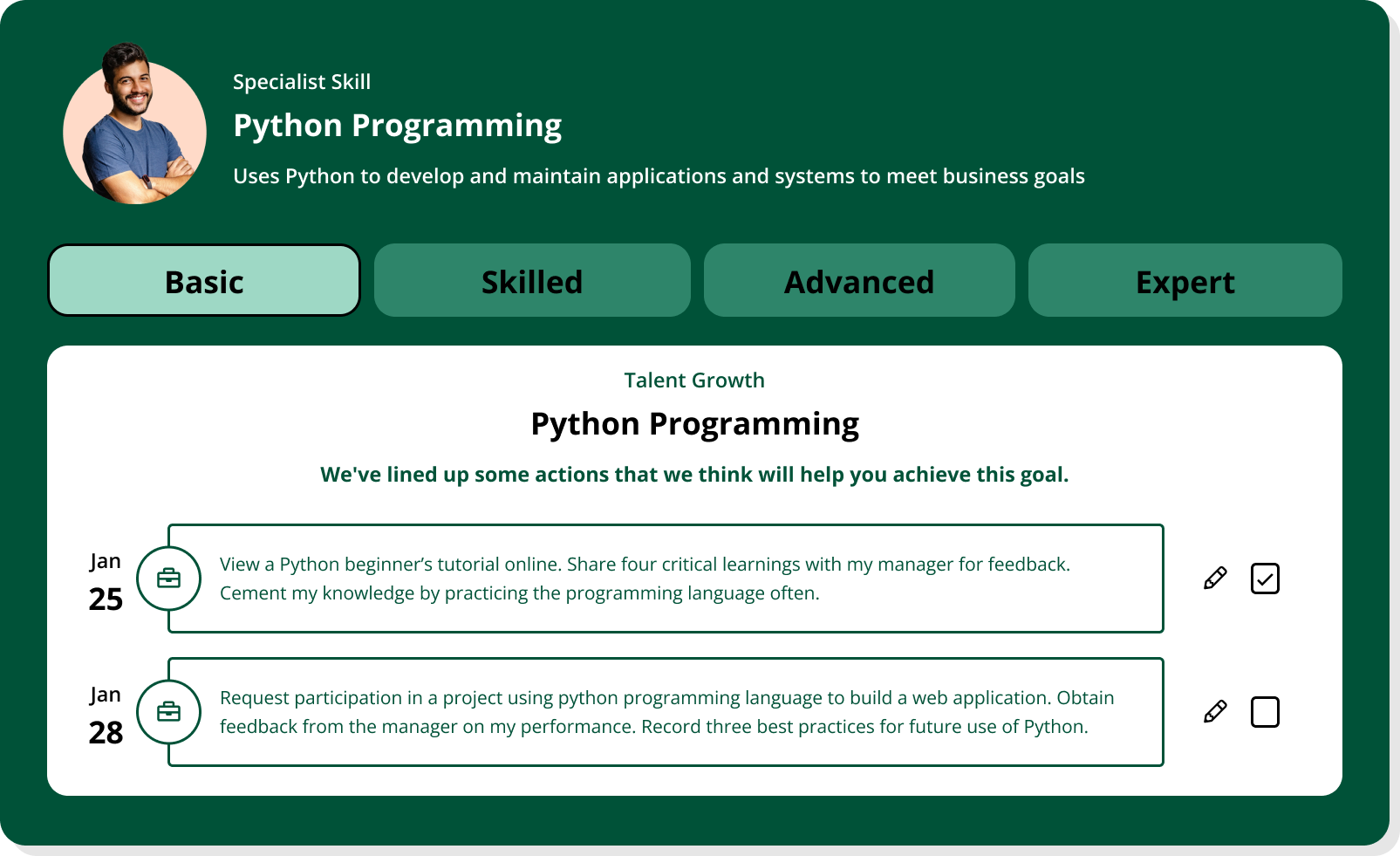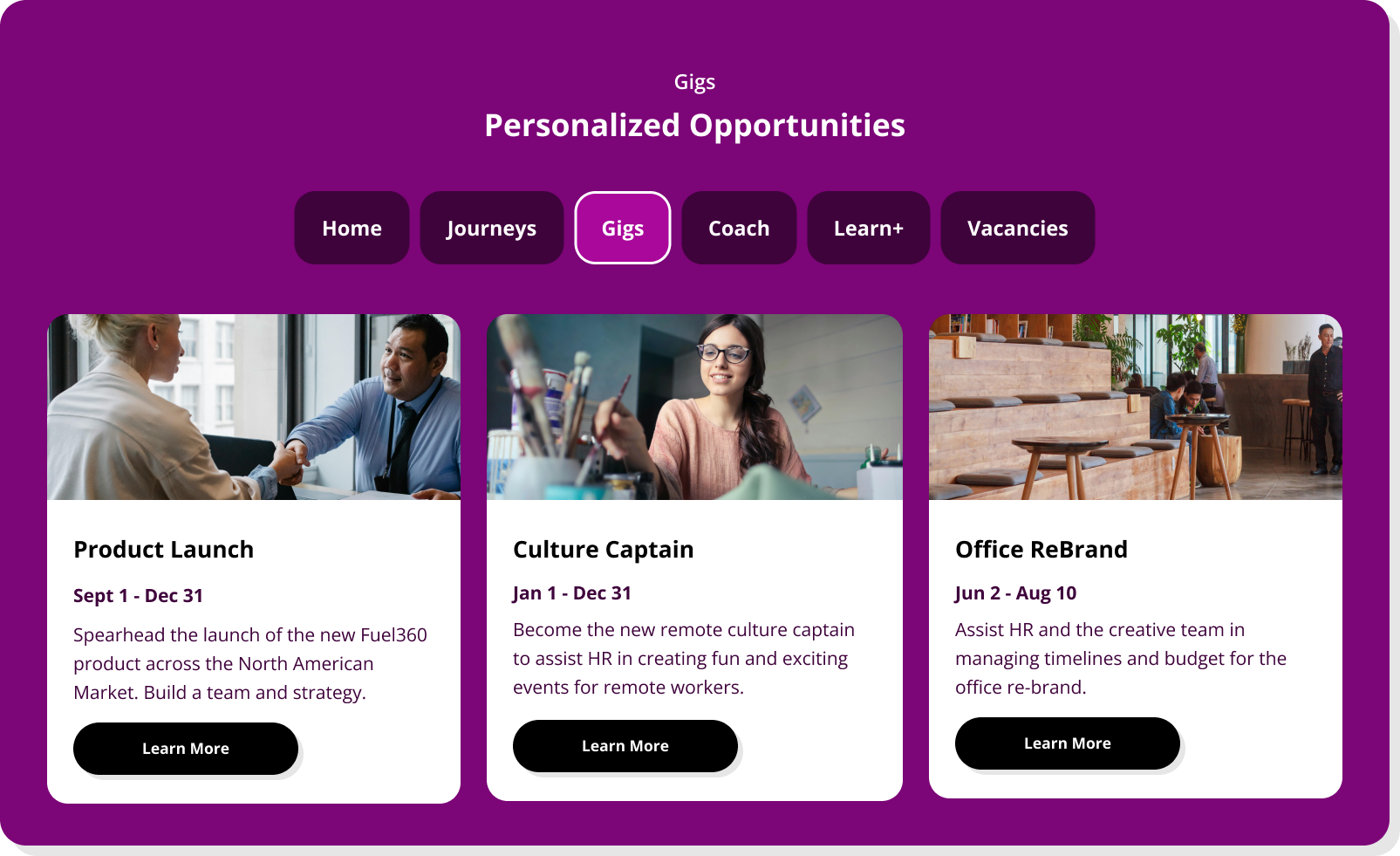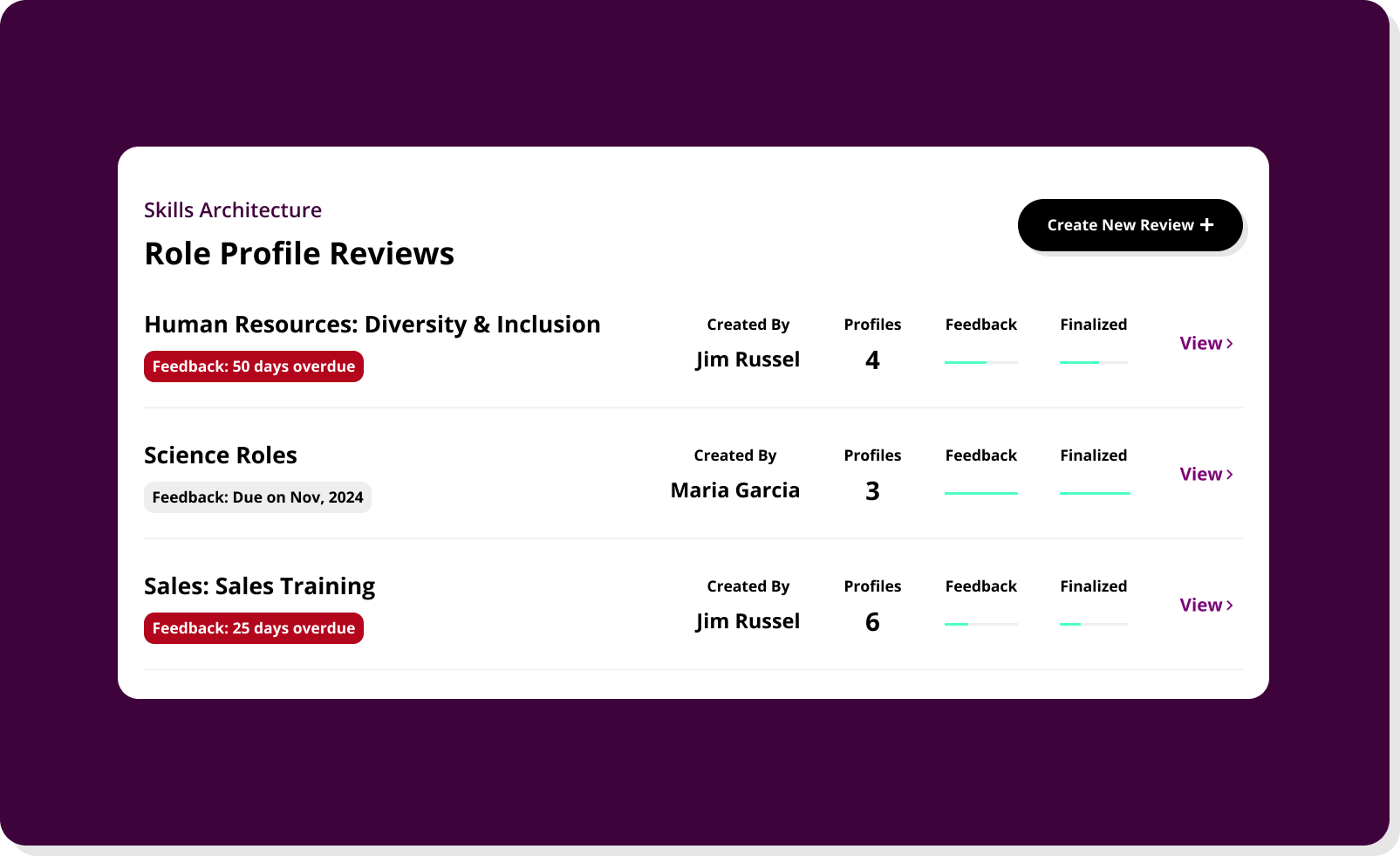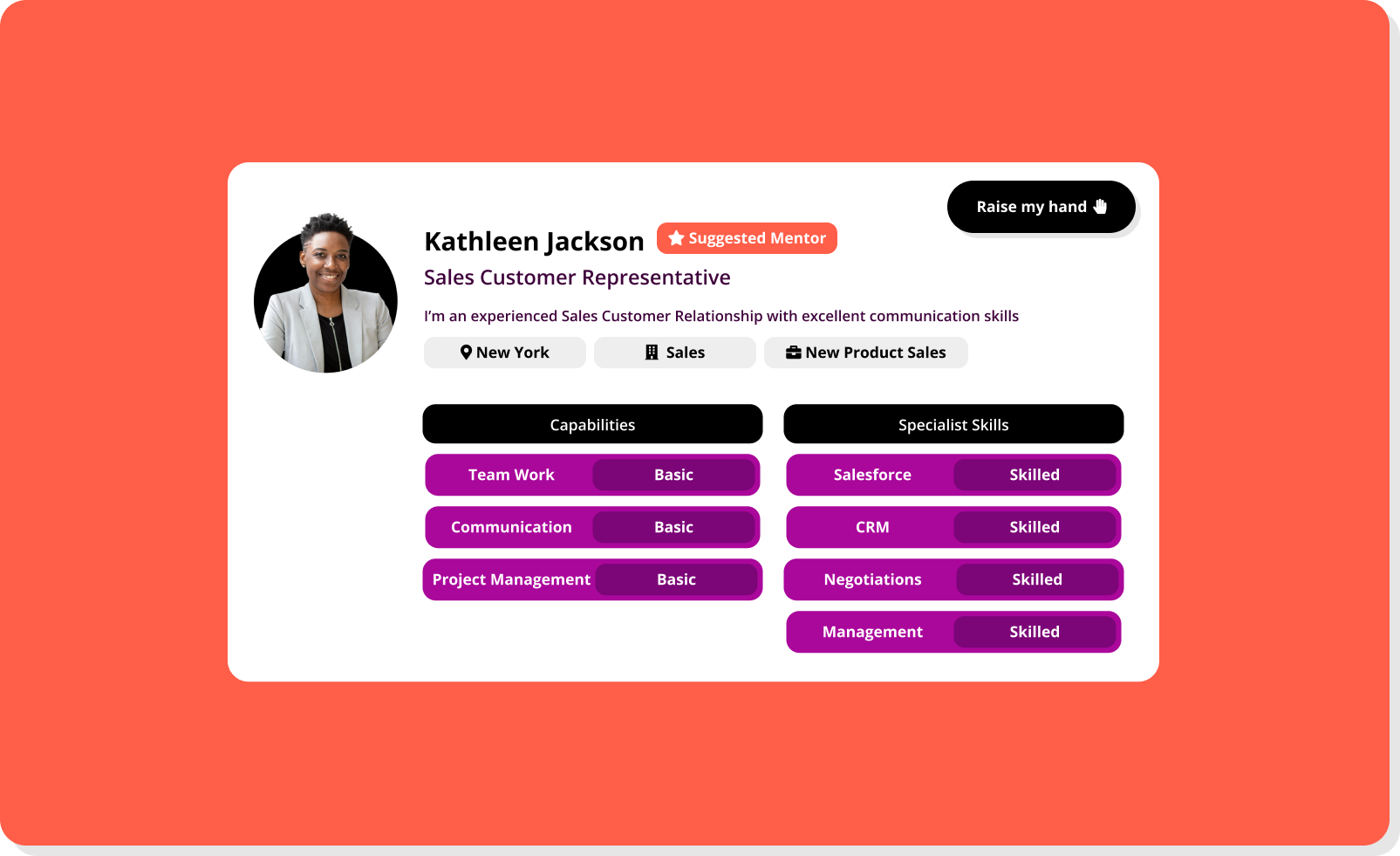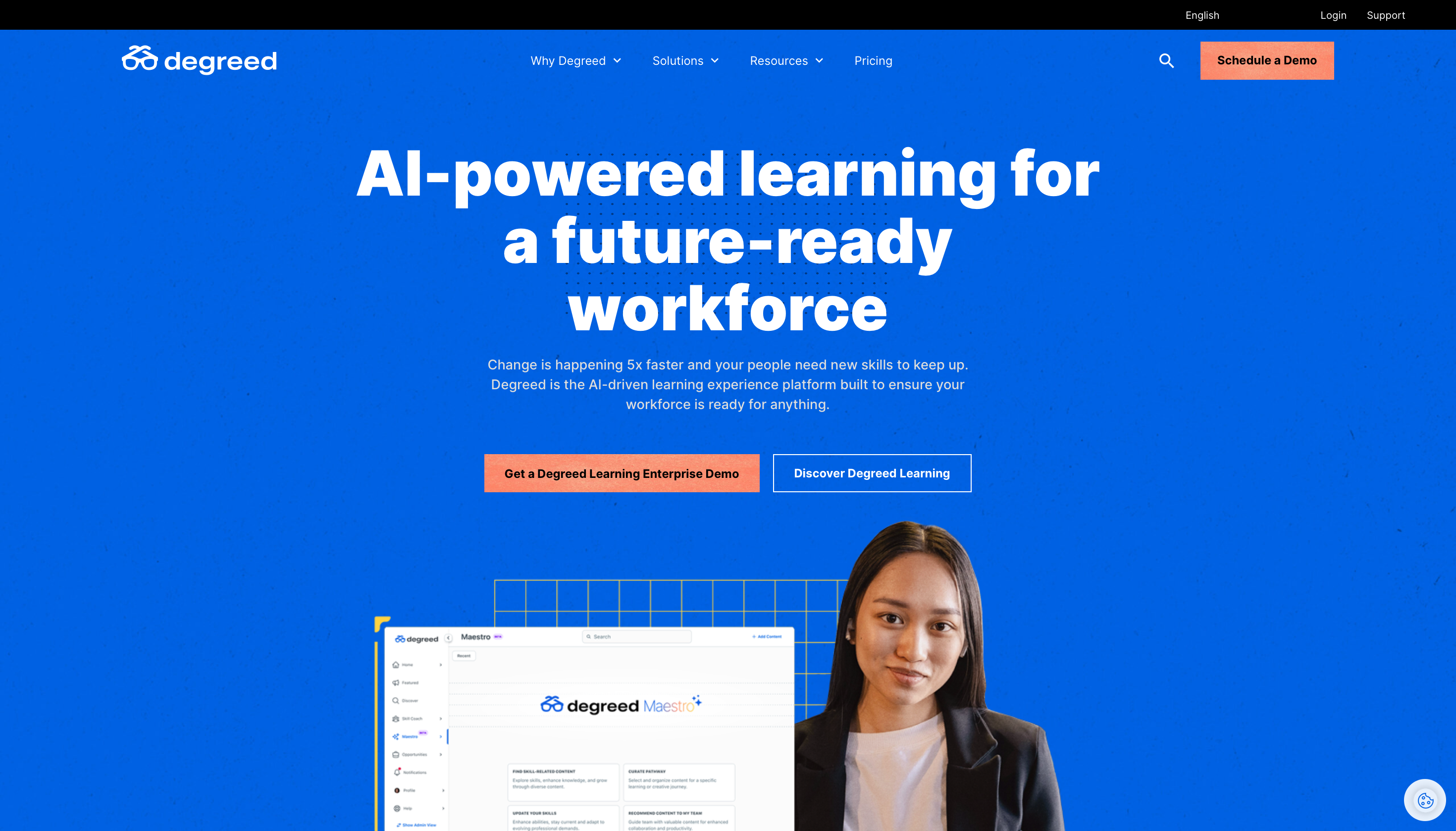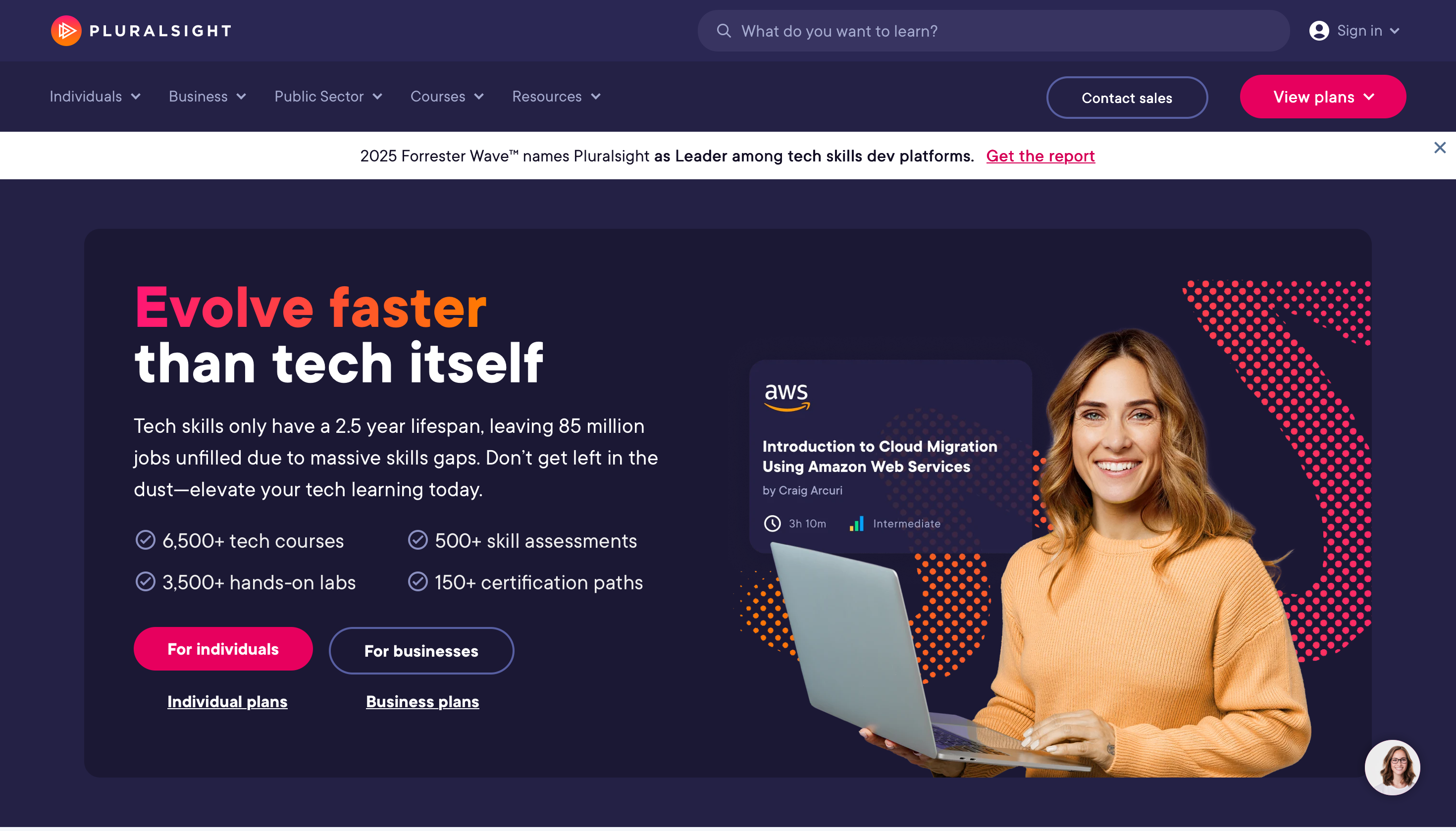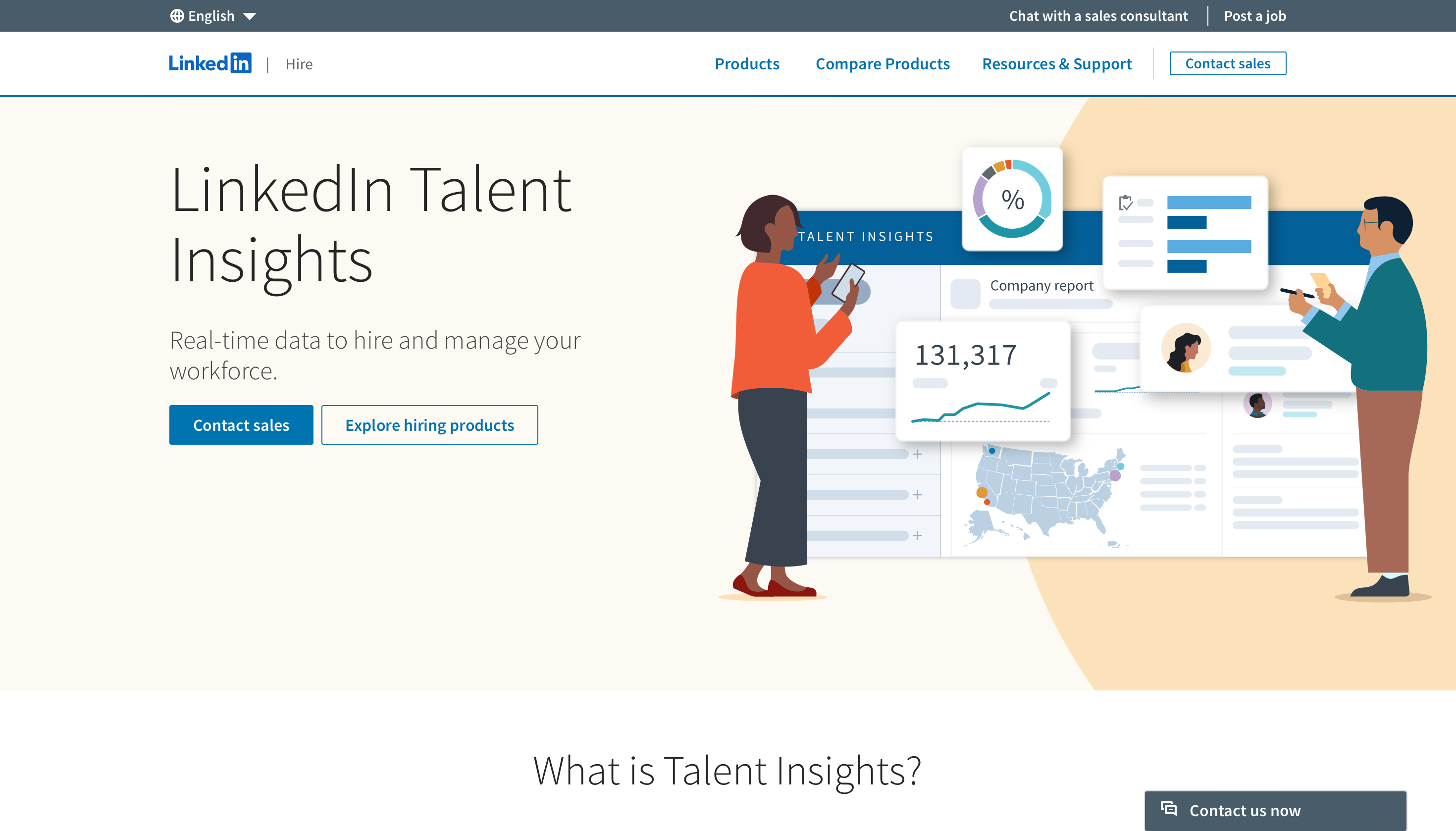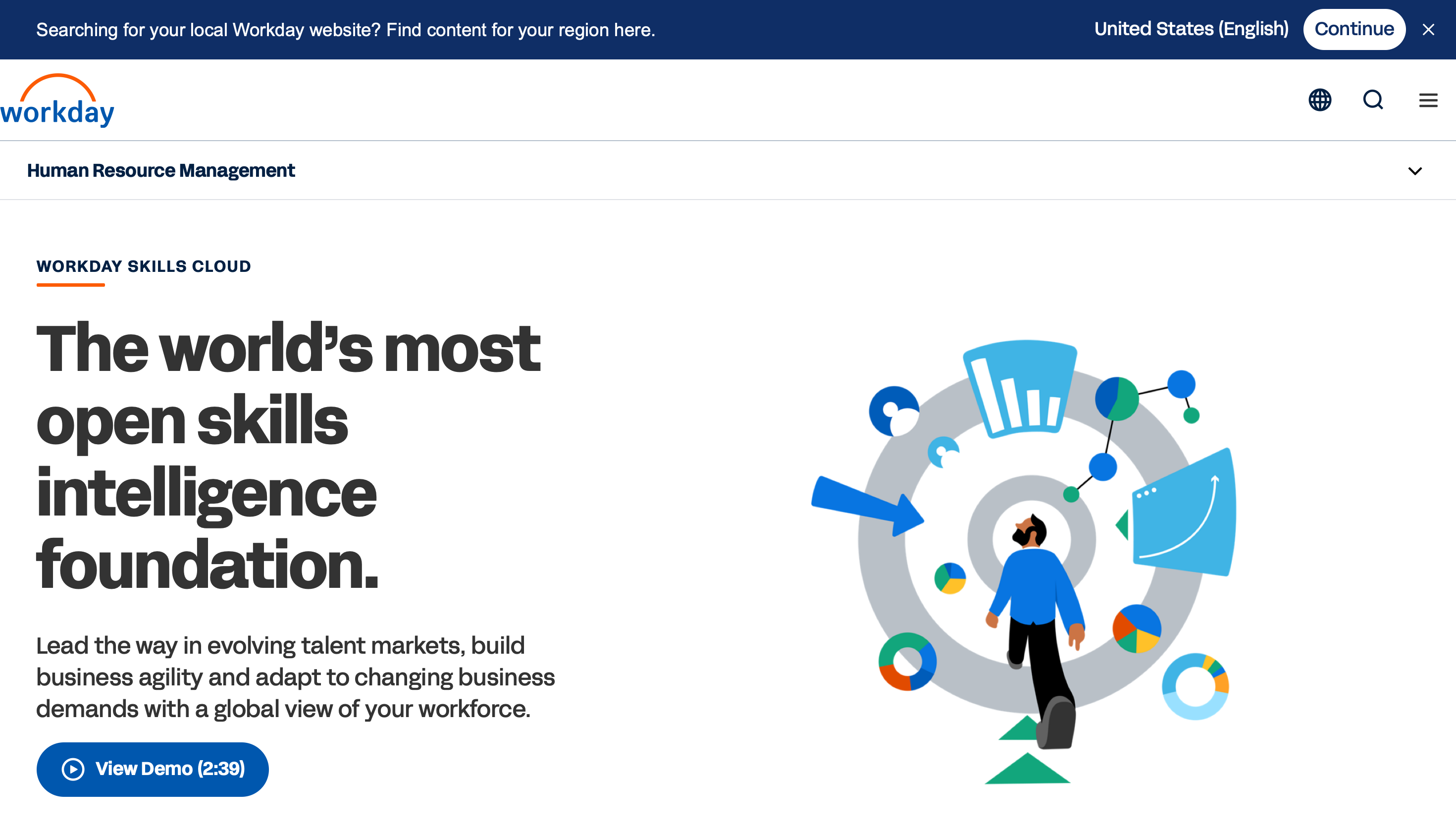A wealth of platforms claim to “help you assess skills.” But once you start digging, the real question becomes, “Assess skills for what purpose?”
Are you trying to personalize learning paths? Plan for future workforce needs? Build internal mobility pipelines? Validate technical capability? Most platforms are built to solve one of these use cases, but few can support all of them.
That’s when things become complicated for talent leaders.
If your goal is to leverage skills data to drive decisions, you need more than a simple self-assessment or AI guesswork. You need a system that captures skills accurately, validates them through context, and feeds that insight back into the day-to-day decisions your business makes about talent, growth, and capability.
In this article, we break down six of the most recognized skills assessment platforms with a critical lens to answer: What are they good at? Where do they fall short? How do you choose a platform that matches the way your organization works?
What to look for in a skills assessment platform?
When evaluating a platform, there are several criteria to consider. Below are the top aspects to consider, along with how each capability separates window-dressing tools from solutions that drive real impact.
Can you trust the accuracy of the data?
Many platforms default to self-assessments, and while those are easy to deploy, they’re notoriously unreliable. Employees either overinflate their skills or underreport them due to gaps in confidence.
As a result, your workforce data becomes skewed, making it impossible to plan effectively or pinpoint gaps.
What you want instead is a system that allows for multi-source validation. That includes managerial reviews, peer feedback, learning completion data, and even gig or project experience that demonstrates application of a skill. Platforms that support this give you a far more defensible and trustworthy foundation for workforce decisions, whether you’re planning succession or identifying readiness for promotion.
Can it integrate into the systems you already use?
The goal isn’t to add another silo to your tech stack. A good skills assessment platform should incorporate cleanly into your existing HCM, ATS, LMS, and performance tools.
But integration isn’t just about APIs; it’s about data continuity. Can the platform pull in past performance data or learning history to enrich skill profiles? Can it feed skills intelligence back into planning tools or learning journeys?
Does it enable action?
One of the biggest complaints we hear from HR teams is, “We have skills data but can’t do anything with it.” It’s just a static snapshot in a dashboard that doesn’t translate into action.
Skills data should empower talent movement, namely, career development conversations, targeted L&D recommendations, internal mobility opportunities, mentoring matches, or readiness for critical roles.
If your platform assesses skills but doesn’t feed that data into personalized actions for employees and leaders, it’s simply measuring, not driving value.
Can it reflect your organizational reality?
Enterprises aren’t one-size-fits-all. Job titles, career paths, and even what a “strategic skill” means can vary widely across business units, geographies, and teams. If a platform forces you into a generic skills taxonomy, you’ll struggle to gain buy-in, and the data will feel disconnected from how people work.
Configurability is non-negotiable. You should be able to align the platform’s skill frameworks with your existing job architectures, role families, and strategic priorities. You should also be able to localize for regional or functional needs. Most importantly, as your business evolves, the platform needs to change with it.
6 Skills assessment platforms you can rely on
Skills are the currency of modern talent strategy, but collecting skills data is only useful if you can trust it, act on it, and connect it to outcomes that matter.
That’s where most platforms fall short. Some emphasize learning but can’t support workforce planning, while others lean on AI to infer skills but lack validation or human context. Many treat assessment as a one-time event rather than a dynamic, evolving view of your workforce’s capabilities.
With that in mind, below are six skills assessment platforms you can rely on for comprehensive insights full of depth.
Fuel50: Best for organizations building a strategic, skills-based talent ecosystem
Fuel50 is a skills-powered talent marketplace and workforce intelligence engine built from the ground up to help enterprises understand, grow, and mobilize their people to support business goals.
While most tools on this list specialize in a single function—like learning personalization, technical validation, or AI-based talent discovery—Fuel50 is designed to create a living, evolving picture of your workforce’s skills, capabilities, and potential, and realize that picture as action.
Here’s what makes Fuel50 fundamentally different.
Built on an enterprise-grade skills ontology
The core of Fuel50 is a dynamic skills ontology developed and maintained by a team of I/O psychologists. Instead of a vendor-sourced taxonomy or a static list of generic competencies, it’s a living, breathing framework informed by real-world data, job evolution, and behavioral science.
That’s important, because most organizations want to do more than assess skills—they want to trust the data they’re building their talent strategies around.
Fuel50’s ontology ensures every skill is clearly defined, behaviorally anchored, and mapped to existing roles and potential career paths. And, unlike platforms that force you into a rigid framework, Fuel50 allows you to customize the ontology to reflect your organization’s unique language, structure, and strategic priorities.
Whether it’s workforce planning, succession, DEI, or upskilling, with Fuel50, you’re working from a credible foundation for career growth and development.
Skills assessments are continuously enriched
Where many platforms treat skills assessment as a point-in-time survey, Fuel50 adapts skill profiles dynamically over time.
Employees start with a self-assessment. Then, the system encourages skill validation through managerial input, peer feedback, gig and project completion, learning history, and career goals. The result is a multidimensional view of each employee; not just what they say they can do, but what they’ve demonstrated, developed, and aspire to.
Thanks to this enrichment process, skill profiles in Fuel50 become more precise the more people use the platform.
The longer the system is live, the more valuable your skills data becomes. It serves as not just a reflection of individual talent, but also an input to team capability planning, talent segmentation, and strategic resourcing.
This kind of longitudinal, multi-input skill tracking is rare and separates Fuel50 from tools that rely on static self-ratings or AI inference alone.
Actionable intelligence that drives talent decisions
Fuel50 doesn’t believe skills data should live in a dashboard. The platform is built to uncover insights in critical areas, namely, HR, managers, and employees.
For HR, this yields visibility into skills gaps tied to business goals, readiness mapping for strategic roles, and internal talent supply for critical initiatives. It also enables them to forecast workforce capability based on real-time skills data, rather than relying on outdated head count metrics.
Managers are able to spot developmental gaps, succession risks, or mobility opportunities at the team level and are empowered to act on those insights without waiting for HR to drive the process.
As for employees, the information reveals where their skills fit into the broader organization, how to grow them, and where they can go next without needing to leave the company.
These insights become embedded into the workflows, conversations, and talent processes that move people forward.
A skills-powered talent marketplace that closes the loop
Perhaps Fuel50’s biggest differentiator is that it doesn’t stop at insight. It drives action—immediately, and at scale.
The Talent Marketplace allows organizations to deploy talent dynamically through personalized career paths, gigs, mentoring, stretch assignments, and open internal roles.
Every opportunity is matched to the employee’s current skill profile and future development goals, creating a seamless path from skill assessment to skill application.
Organizations use Fuel50 to drive internal mobility, reduce time to fill, improve retention of high-potential talent, and make smarter decisions about when to build versus when to buy.
It’s the feedback loop most platforms never close. Fuel50 enables employees to grow based on comany needs and enables businesses to grow by unlocking the full potential of their workforce.
Designed for global enterprise scale
Fuel50 is designed to handle complexity. Whether you’re a multinational with regional variation in roles, or a decentralized organization with multiple business units and compliance requirements, the platform adapts to your structure, not the other way around.
It integrates into major HCMs (like Workday and SAP), learning platforms, and other HR systems to ensure skills data flows throughout your ecosystem. Role configurations, access permissions, and taxonomy customizations can be tailored to your business’s unique needs without compromising usability.
And because the platform is supported by a rigorous data model, it can accommodate everything from quarterly talent reviews to multi-year workforce transformation strategies.
Degreed: Best for learning-driven skill development
Degreed is often the first name that comes up when companies talk about upskilling, because it’s one of the most well-known platforms in the learning tech space. If your main goal is to centralize content, encourage continuous learning, and use skills data to personalize L&D experiences, Degreed is a solid contender.
Its strength lies in how it maps learning resources to skills. The platform ingests a massive library of courses, content, and credentials (both internal and external) and organzies them into skill development paths. Employees can tag their own skills, receive recommendations on what to learn next, and track their progress.
This is great—if your problem is low learning engagement or decentralized L&D.
But there’s a fundamental limitation that starts to show the moment you try to use Degreed for anything more strategic.
Skills in Degreed tend to live inside the learning context. You know what people are learning, but not necessarily what they’re capable of doing, let alone how those capabilities tie back to internal mobility, succession planning, or workforce forecasting. There’s no deep integration with talent profiles, performance data, or validated skill application. The skills model itself can feel superficial or employee-generated in a way that’s difficult to scale with confidence.
This makes Degreed incredibly useful for learning leaders, but less useful for talent leaders trying to make workforce-wide decisions. If your company is looking to connect skills to career paths, mobility, or long-range planning, you might need to pair Degreed with other systems to fill those gaps.
In short: Degreed is an effective learning experience platform with skills features bolted on, but it’s not a comprehensive workforce intelligence solution.
Eightfold: Best for AI-driven talent insights
Eightfold’s promise is compelling: Apply deep learning to massive datasets (e.g., resumes, public profiles, job descriptions, labor market trends) and uncover hidden patterns in talent.
In many ways, it delivers: Eightfold’s AI engine excels at spotlighting talent you might otherwise miss. For recruiting teams, that reveals candidates who have the right underlying capabilities, even if their job title doesn’t match the posting. Internally, it can identify employees with adjacent skills who could be redeployed or reskilled for high-need roles. This enables you to make better use of the talent you already have (or haven’t yet noticed).
This focus on inference is what makes Eightfold attractive to organizations that struggle with hard-to-fill roles, diversity goals, or untapped internal mobility. But AI alone doesn’t make a platform strategic.
Here’s the trade-off: Eightfold’s skills data is largely machine-inferred. It pulls from resumes, job history, and online sources to guess what someone can do. While that’s valuable at scale, it lacks the nuance and validation that comes from direct skill assessment, managerial input, or on-the-job experience. You gain a wide lens, but sometimes a blurry picture.
That’s a problem if your organization cares about proving capability. You may find that Eightfold’s skill profiles feel disconnected from the reality of your workforce. There’s limited context around how skills were used, how they’ve evolved, or how employees want to grow next. For HR leaders trying to support development, match people to career paths, or build strategic talent pipelines, they end up flying blind.
Also, Eightfold’s interface and implementation process aren’t always lightweight. It’s powerful but can also be complicated. For organizations that lack robust internal analytics support or a clear skills strategy, it’s easy to end up with a highly sophisticated system that’s underutilized or misunderstood.
Bottom line: Eightfold excels at breadth and AI-based discovery but falls short when it comes to validated, context-rich skills intelligence that drives employee action and development. It’s a great engine for discovering possibilities; less so for cultivating long-term talent confidence.
Pluralsight: Best for technical skill validation
Pluralsight delivers high-quality, objective skill assessments for software engineers, IT professionals, cloud architects, and cybersecurity experts, and within that niche, it performs exceptionally well.
Its skill assessments are structured, standardized, and often far more rigorous than the subjective self-ratings that dominate most generalist platforms. For example, developers can take scenario-based coding tests that produce quantifiable scores tied to specific competencies. That level of precision is invaluable for engineering managers trying to understand team readiness, benchmark talent, or identify targeted areas for growth.
If you’re running a product or dev organization and need to validate whether your team is up to speed on React, Python, or AWS, Pluralsight offers a clear, actionable answer. It even incorporates into tech workflows so teams can assign skill-based learning and track proficiency over time.
But that’s where the value mostly ends.
Pluralsight is not a workforce intelligence platform, but a specialized learning and assessment tool for technologists. Outside of engineering, it offers little relevance. There are no tools to model soft skills, leadership capabilities, or business acumen; there’s no functionality around talent mobility, succession planning, or workforce planning; the skill taxonomy isn’t designed to map to enterprise-wide role families or strategic priorities; and the platform wasn’t built with HR teams in mind.
If you try to apply Pluralsight’s assessment model across your organization, you’ll quickly hit a wall. It’s neither configurable for non-technical roles, nor will it give you a holistic view of your company’s skill landscape.
So, as a point solution for validating technical talent, it’s excellent. But if you’re looking for an enterprise-wide skills platform that can inform broader workforce decisions, you’ll need something else alongside it.
LinkedIn Skills Insights: Best for lightweight visibility
LinkedIn Skills Insights is exactly what the name suggests: a tool that gives you surface-level visibility into the skills of your workforce. It’s lightweight, easy to access, and can serve as a quick reference point when you need to benchmark internal capabilities against industry trends.
You can view trending skills in your industry, compare your talent pool to competitors, and explore which skills are emerging within certain functions. If you’re an HR leader thinking about skills strategy and want to gain a rough sense of where your workforce stands, LinkedIn offers a helpful, frictionless starting point.
However, that’s also its ceiling.
The data is pulled from LinkedIn profiles, which means it’s only as accurate as what employees choose to include (and how frequently they update it). There’s no validation layer, no internal context, and no insight into how those skills are applied inside your organization. You work with external-facing metadata, not workforce intelligence.
There’s also no configurability. You’re unable to customize taxonomies to reflect your internal roles, tag strategic priorities, or connect the data to development, mobility, or planning workflows. It’s benchmarking without action.
LinkedIn Skills Insights is valuable for directional awareness, but not for decision-making. If you’re looking for a tool to guide strategic workforce planning, prioritize development efforts, or inform internal mobility decisions, LinkedIn simply doesn’t have the depth, validation, or system integration to support those goals.
Workday Skills Cloud: Best for Workday-native environments
If your organization already runs on Workday, Skills Cloud might be the most logical choice. It’s natively embedded, integrates well into Workday’s talent suite, and is pitched as the backbone for a unified skills strategy across performance, learning, recruiting, and planning.
The concept is attractive: Workday uses AI to infer skills from job history, roles, and activity across the platform. As people engage with learning, update profiles, or move internally, the Skills Cloud continuously updates their skill graph. For companies already established in the Workday ecosystem, this offers a sense of cohesion and minimal lift in terms of new tools or integrations.
Unfortunately, that convenience comes with noteworthy trade-offs.
First, the AI-based skill inference model, while sophisticated, can be shallow. It often infers skills based on job titles or learning completions, which can misrepresent actual capabilities. For example, just because someone completes a course in strategic thinking doesn’t mean they’ve demonstrated the skill or are ready for a leadership track. The system assumes proficiency where none may exist and lacks mechanisms for human validation or context.
Second, the skill ontology itself isn’t especially configurable. Many organizations find it difficult to align Workday’s taxonomy with their own frameworks. You might be able to tweak names or map internal roles, but true customization—for different regions, business units, or strategic initiatives, etc.—is limited. This makes it hard to use the Skills Cloud as a central intelligence layer if your workforce structure is complex.
Finally, although Workday gathers skill insights, it stops short of enabling meaningful action: It doesn’t connect skills directly to internal gigs, mentoring, or personalized career paths, nor does it offer employees an intuitive, engaging experience for skill growth or visibility. In short, it tells you what might exist but doesn’t help you build towards the future.
Workday Skills Cloud is a good fit if your priority is consistency within a Workday environment and your expectations are modest. But if you’re crafting a skills strategy that demands depth, accuracy, configurability, and employee activation, you may quickly reach its limits.
How to choose the right platform for your organization
The right choice depends on what you’re trying to solve, who needs to use the system, and how deeply you want to integrate it within your broader talent strategy.
Start with use case clarity. Are you trying to increase learning engagement? Fuel internal mobility? Plan for future workforce needs? Different platforms lean in different directions. A tool like Degreed, for example, is ideal for learning-driven development, but won’t help you model succession or construct a skills-based talent pipeline. Eightfold, on the other hand, is excellent at surfacing hidden talent through AI, but struggles with employee-level validation and developmental context. If your goal is strategic workforce planning or activating talent from within, those trade-offs matter.
Next, think about organizational complexity. If you’re a global enterprise with regional differences, business unit-specific needs, or data privacy requirements, configurability is a must. A rigid platform that imposes a one-size-fits-all taxonomy or blocks granular controls will create friction and stymie adoption. Enterprise-ready tools allow you to link skills to job structures, manage access based on location or function, and support different talent strategies across the business.
And, perhaps most importantly, don’t stop at assessment. The value of skills data isn’t in the profile—it’s in the ability to act on it. Can the platform trigger developmental plans? Recommend gigs or mentoring? Inform succession planning or mobility conversations? Can it feed insight into the tools your leaders and employees already use? If not, your data will grow stale in a silo—accurate, maybe, but useless.
The right platform goes beyond showing you who can do what; it helps you build, develop, and deploy your workforce in smarter ways. This is critical to make it worth your time and budget.





